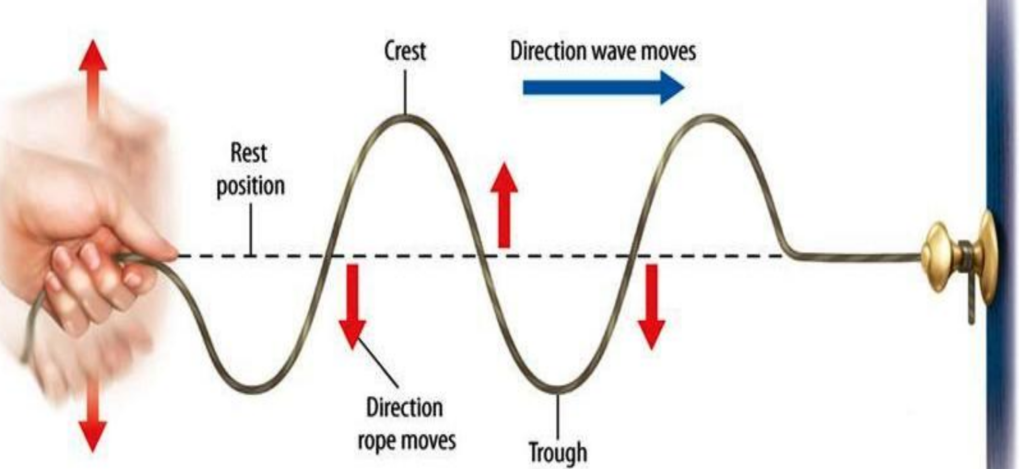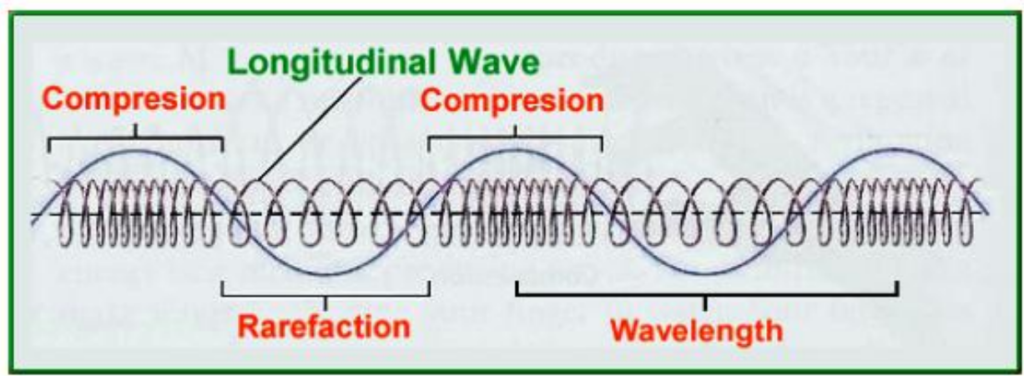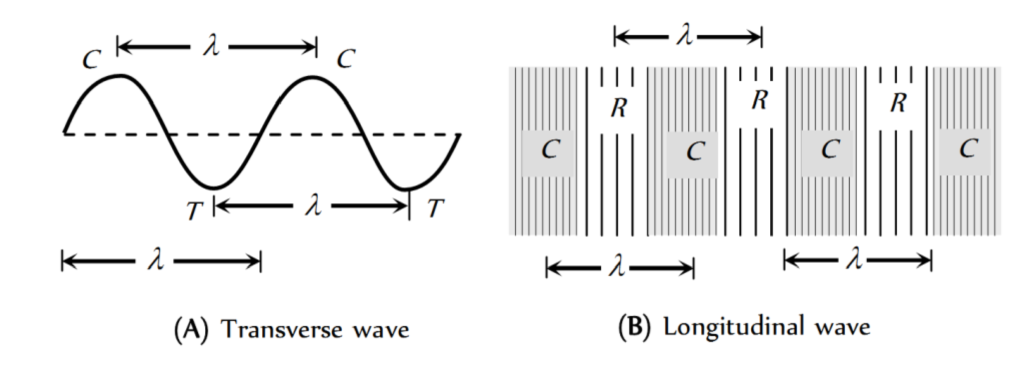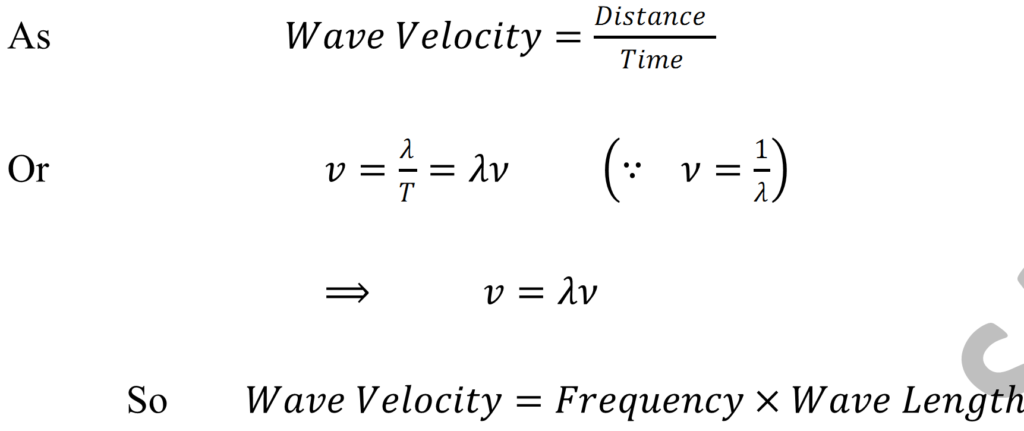Chapter 11 Sound
Sound
Nature of sound and its propagation in various media, speed of sound, range of hearing in humans; ultrasound; reflection of sound; echo.
Waves
-
Waves Motion:
It is a disturbance which travels through a medium due to vibrations of the particles of the medium about their mean position. The disturbance is handed from one particle to the next particle.

- In a wave motion both information and energy is transferred in form of signal from one place to another place.
- For example when a stone is dropped in pond of water then a circular pattern of alternating crest and trough is formed due to vibration of particles of water. These particle transfers energy from one layers to another layer and when a piece of paper is placed on water surface then it does not moves, show that during wave motion the particle of the medium does not moves.
Characteristics of Wave Motion:
- In wave motion disturbance moves in a medium due to vibration of the particle of the medium.
- The energy is transferred during wave motion.
- There is a little phase difference between vibrations of the particle.
- The velocity of wave motion is different from velocity of vibrations of the particles.
- The velocity of particles is maximum at mean position and zero at extreme positions. While wave velocity remains constant in medium.
- There should be elasticity, properties of inertia and minimum friction for propagation of a wave.
- Types of Wave: Waves are mainly of three types:
-
Mechanical Wave:
The wave which requires a material medium for propagation is called M.W.
e.g: Water waves, sound waves, seismic waves (waves produced during earth quake).
- The propagation of M.W. depends upon elastic properties of medium so also called elastic waves.
-
Electromagnetic Waves:
The waves which travel in from of oscillating electric and magnetic field and do not require any material medium for their propagation is called E.M. waves. e.g: Visible and ultraviolet lights, radio waves, micro waves, infrared waves, rays and rays.
(iii) Matter Waves:
The waves associated with material particles, when they are in motion are called matter waves. These waves have significance in microscopic particles.
e.g: Electron microscope uses matter wave associated with fat moving electron.
Spring Model for Propagation of a Wave through an Elastic Medium: or
-
Propagation of Sound Waves through Air:
If we suppose a small region of air as spring, connected with other small regions or spring. When sound waves moves through air then it compresses or expand a small region.

When there is compression in one region then there is rarefaction in other region. Thus compression and rarefaction moves from one region to another region which causes the propagation of wave in a medium.
-
Propagation of Sound Waves in Solids:
In solids, we can assume that each atom is connected with other neighboring atom with a elastic spring.
When sound wave propagates through solid then atoms displaces from their equilibrium produced by this force travel to next atom and so on. In this way a wave propagate in solids.
-
Transverse Waves:
The wave in which the particle of the medium vibrates perpendicular to the propagation of waves is called transverse waves.

Suppose a string whose one end is fixed and when a jerk is given to the other end held in hand, then a crest or trough is forms in string which moves toward other fixed end of the string.
Each part of the string vibrate up and down while wave along the string so the wave in the string are transverse in nature.
The point of maximum displacement in upward direction are called crest and the points of maximum displacement in downward direction are called trough. One crest and one trough together from a wave.
-
Longitudinal Waves:
The waves in which the particle of medium vibrates along the propagation of waves are called longitudinal waves for example.

Suppose if we push or pull a piston in a small hollow cylinder filled with some air then sound wave travel in from of alternating Compressions and rarefactions. The oscillations of particle are parallel to propagation of wave. Thus sound waves are longitudinal waves.
- A transverses wave can be produced in solids or string and not in fluids as it moves in from of crest and trough.
- But due to surface tension, the free surface of liquid maintains its level so transverse waves can be formed on liquid surface.
- Longitudinal waves can be propagating in all three mediums solid, liquid and gas.
-
Some Definitions in Connection with Wave Motion:

- Amplitude(A):
The maximum displacement of the particle of medium about their mean position is called amplitude.
- Time Period(T):
The time in which a particle complete its one vibration to and fro about mean position is called time period.
- Frequency( 𝜈 ):
The number of waves produced in a medium per unit time is called frequency of the wave

- Angular Frequency(𝜔):
The rate of change of phase of wave is called angular frequency of the wave

- Wave Length (𝛌 ):
The distance between two successive crest or trough is called wave length.
Or
The distance of a crest and trough is called wave length.
- Wave number (𝜈̅ ):
The number of wave present in unit distance is called wave number.
It is equal to reciprocal of wave length .

- Angular Wave Number or Propagation Constant(K):
The wave number multiplied by phase 2π is called angular wave number.

- Wave Velocity or Phase Velocity:
The distance travelled by wave per unit time in its direction of propagation is called its wave velocity or phase velocity.
- Relation between Wave Velocity, Frequency and Wavelength:

-
Speed of Sound
Speed of sound in solids > Speed of sound in liquids > Speed of sound in gases.
However, in certain solids, the speed (v) of sound is much less than that even in gases as v (for vulcanized rubber) = 54 m/s and v (for hydrogen) = 1284 m/s. The speed of sound in lead (a solid) = 1332 m/s and in sea water (a liquid) = 1531 m/s. The speed of sound in methyl alcohol (a liquid) = 1103 m/s and in hydrogen (a gas), its value = 1284 m/s.
The speed of sound increases with increase in temperature of the medium. In air, it increases roughly by 0.61 m/s with rise of 1°C in temperature. The speed of sound in air at 0°C is 331 m/s and at 22°C, it is 344 m/s.
-
Factor Affecting Speed of Sounds in A Gas:
-
Effect of Pressure:
When pressure a change, then density is also changes in same ratio, thus there is no any effect of pressure on speed of sound waves.
-
Effect of Density:
Hence at constant pressure, the speed of sound in a gas inversely proportionality to the square root of the densities.
(iii)Effect of Humidity:
As the density of water vapor is less than that of dry air so sound travel faster is moist air then dry air.
(iv)Effect of Temperature:
Hence speed of sound in a gas is directly proportional to the square root of it absolute temperature.
(v)Effect of wind:

As sound moves with the help of wind or air, if wind in direction of sound then speed of sound increases and when wind flow in opposite to direction of sound then speed of sound decreases.
(vi)Effect of Frequency:
The speed of sound is not affected by the frequency of sound.
(vii)Effect of Amplitude:
To a large extent, speed of sound wave is independent on amplitude of the waves.
9. RANGE OF HEARING
Human are not good to hear the sound. The human ear is able to hear sound in a frequency range of about 20Hz to 20 kHz only. We are not able to hear sounds of frequencies less than 20Hz of more than 20 kHz; these limits vary from persons to person and with age. Children can her sounds of somewhat higher frequencies, say up to 30 kHz. With age, our ability to hear high frequency sound diminishes. For the elder, the upper limit often falls to 10-12 kHz. We take 20Hz-20 kHz as the audible range for a average person.
Even in the audible range the human ear is not equally sensitive for all frequency. it is most sensitive to frequencies around 2000-3000 Hz.
Sound of frequencies less than 20 Hz is known as infrasonic sound or infrasound. Sound of frequency greater than 20 kHz is known as ultrasonic or ultrasound.
Different animals have different ranges of audible frequencies. A dog can hear sound of frequencies up to about 50 kHz and a bat up to about 100 kHz. Dolphins can hear sounds of even higher frequencies. Animals such as elephants and whales can hear sounds of frequencies less than 20 Hz. Some fishes can hear sounds of frequencies as low as 1-25 Hz.
-
Characteristics of Musical Sound
Music:
The sound which has a pleasing sensation to the ears is called music.
e.g: The sound produced by sitar, violin and table are music.
Noise:
The sound which has none pleasing or jarring effect on ears is called noise.
e.g: The sound produced by explosion, from market etc.
- Characteristics:
There are three characteristics of musical sounds (i) Loudness (ii) Pitch (iii) Quality or Timbre
(i) Loudness:
The amount of energy crossing per unit area around a point in one second is called loudness.
(ii) Pitch:
It is a sensation which helps a listener to distinguish between a high and a grave note. It depends on frequency. The pitch of a lady’s sound is higher than that of a man.
(iii) Quality or Timbre:
Quality of sound helps us to distinguish between two sounds of same pitch and loudness. It is due to quality due to which we can recognize one’s friend without seeing him.
12. ULTRASOUND
Sound of very high frequency (greater than 20 kHz) is called ultrasound.
Production:
These are produced by electric oscillator using high frequency vibrations of quarts crystal.
Properties:
Sound wave of all frequencies carries energy with them, with increase in frequency, vibration becomes faster and both energy and force increase. When ultrasound travels in solid, liquid and gas it subjects the particles of matter to face large force and energy.
13. APPLICATIONS OF ULTRASOUND:
In contrary to audible sounds (which have lower frequencies), ultrasound can be obtained in the form of a narrow beam which can travel along well-defined paths even in the presence of obstacles. Such well-defined narrow beams of ultrasonic waves find application in many fields.
- Industry
- Medical science
- Communication (SONAR)
Industrial uses of ultrasound:
The various uses of ultrasound in industries are as follows :
- Cleaning instruments and electronic components: An instrument that needs cleaning but whose parts cannot be reached directly is placed in a liquid. The ultrasonic waves passing through the liquid produce tiny bubbles where the rarefaction of the ultrasonic wave reaches. This leads to the creation of several shockwaves. These shock waves blast away any dirt or contamination from the unreachable portions, usually, frequencies in the range of 20 kHz to 30 kHz are used for this purpose.
- Plastic welding: Application of small pressures and ultrasonic vibration to two similar surfaces produces sufficient thermal energy to bond the surface together.
- Detecting flaws and cracks in metal blocks: To construct big structures like buildings, bridges, machines and scientific equipment, a large number of metallic blocks are assembled together. Cracks and holes within the blocks, which are invisible from outside, reduce the strength of a structure. To detect these flaws (cracks and holes) in a block, ultrasonic waves are passed through it.
Medical uses of ultrasound:
- Echocardiography: It is used to study the heart-valve action. An image of the heart is obtained by getting ultrasonic waves reflected from various parts of the heart.
- Ultrasonography: It involves sending ultrasonic waves to various organs (like brain, liver, kidneys) in the body and looking at the reflected or transmitted waves. Using ultrasonography, stones in gall-bladder and kidneys or tumors in different organs can be detected. Ultrasonography is also used in prenatal examinations.
- Therapeutic uses: Ultrasound is used for treatment of neuralgic and rheumatic pains.
14. REFLECTION OF SOUND:
When sound waves strike a surface, hey return back into the same medium. This phenomenon is called reflection.
LAWS OF REFLECTION:
- Angle of incidence is equal to the angle of reflection.
- The incident wave, the reflected wave and the normal, all lie in the same plane.
15. Echo
The phenomenon where a sound produced is heard again due to reflection is called an echo.
E.g.: Clapping or shouting near a tall building or a mountain.
To hear distinct echo sound, the time interval between original and reflected sound must be at least 0.1s. As sound persists in our brain for about 0.1s. Minimum distance for obstruction or reflective surface to hear an echo should be 17.2 m. multiple echoes can be heard due to multiple reflections.
To download class 9 chapter 11 sound click on the link given below
class 9 chapter 11 sound
